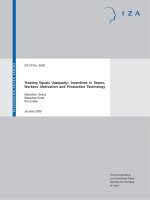Telecommunication-lecture 01-Overview potx
Bạn đang xem bản rút gọn của tài liệu. Xem và tải ngay bản đầy đủ của tài liệu tại đây (288.81 KB, 21 trang )
William Stallings
Data and Computer
Communications
8
th
Edition
Chapter 1
Data Communications, Data
Networks, and The Internet
A Communications Model
•
Source
—
generates data to be transmitted
•
Transmitter
—
Converts data into transmittable signals
•
Transmission System
—
Carries data
•
Receiver
—
Converts received signal into data
•
Destination
—
Takes incoming data
Simplified Communications
Model - Diagram
Communications Tasks
Transmission system utilization Addressing
Interfacing Routing
Signal generation Recovery
Synchronization Message formatting
Exchange management Security
Error detection and correction Network management
Flow control
Simplified Data
Communications Model
Networking
•
Point to point communication not usually
practical
—
Devices are too far apart
—
Large set of devices would need impractical number
of connections
•
Solution is a communications network
—
Wide Area Network (WAN)
—
Local Area Network (LAN)
Wide Area Networks
•
Large geographical area
•
Crossing public rights of way
•
Rely in part on common carrier circuits
•
Alternative technologies
—
Circuit switching
—
Packet switching
—
Frame relay
—
Asynchronous Transfer Mode (ATM)
Circuit Switching
•
Dedicated communications path established for
the duration of the conversation
•
e.g. telephone network
Packet Switching
•
Data sent out of sequence
•
Small chunks (packets) of data at a time
•
Packets passed from node to node between
source and destination
•
Used for terminal to computer and computer to
computer communications
Frame Relay
•
Packet switching systems have large overheads
to compensate for errors
•
Modern systems are more reliable
•
Errors can be caught in end system
•
Most overhead for error control is stripped out
Asynchronous Transfer Mode
•
ATM
•
Evolution of frame relay
•
Little overhead for error control
•
Fixed packet (called cell) length
•
Anything from 10Mbps to Gbps
•
Constant data rate using packet switching
technique
Local Area Networks
•
Smaller scope
—
Building or small campus
•
Usually owned by same organization as attached
devices
•
Data rates much higher
•
Usually broadcast systems
•
Now some switched systems and ATM are being
introduced
LAN Configurations
•
Switched
—
Switched Ethernet
•
May be single or multiple switches
—
ATM LAN
—
Fibre Channel
•
Wireless
—
Mobility
—
Ease of installation
Metropolitan Area Networks
•
MAN
•
Middle ground between LAN and WAN
•
Private or public network
•
High speed
•
Large area
The Internet
•
ARPANET (1969)
•
TCP/IP
—
Transmission Control Protocol-TCP (1974)
—
Internet Protocol – IP
•
Key Elements
—
Hosts
—
Network connected by Routers
—
IP Packets
—
IP Address
Internet Architecture
Example
Networking
Configuration
CPE – Customer Premises Equipment
CO – Central Office
ISP – Internet Service Provider
NAP – Network Access Point
NSP – Network Service Provider
POP – Point of Presence
Central Office Operation Lab
•
Signaling Circuit: hook status, dialed number
detection, and ringing
•
Digital Switching: time-division switching, Space
switching
•
System Control: routing sequences and call
processor functions
•
Supplementary Services: Caller Id, forward call,
*67, *69, etc.
Subscriber Connection Lab
•
Mr. Dang Quang Vinh
•
Lab 1
—
Telephone Line Interface
•
Ringing
•
Supervision
•
Codec – Pulse Code Modulation
—
Subscriber Signaling
Further Reading
•
Stallings, W. [2004] Data and Computer
Communications (7th edition), Pearson Prentice
Hall, Upper Saddle River NJ, chapter 1
—
6 copies are available in our library.
•
Web site for Stallings book
•
/>Chapter One Review Questions
•
Define the following terms:
—
Addressing, routing, signal generation, error
detection and correction, interfacing, flow control
•
Briefly describe how data is transmitted from
Point A to Point B
•
What is point-to-point communication, and why
is it not usually practical
•
Describe the differences between LANs, MANs,
and WANs
•
Compare and contrast circuit switching and
packet switching









